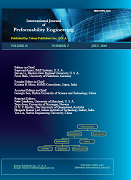-
Question-based Methodology for Rating the Severity of Defects in Construction Through on-Site Inspection
- Bessa Rui, Costa Jorge, and Calejo Rui
-
2019, 15(7):
1760-1771.
doi:10.23940/ijpe.19.07.p2.17601771
-
 Abstract
Abstract
 PDF (485KB)
PDF (485KB)

-
References |
Related Articles
The impact of defects in construction is still not well-defined, and it is challenging to quantify all related indirect variables numerically. The majority of the studies in this field focus on the direct impact of defects on costs and planning, neglecting other indirect impacts that are more difficult to measure. Hence, it is vital to evaluate and classify the defects based on their impact, so that priorities can be defined for action both in their correction and prevention. In this work, a generalized methodology to grade the severity of defects was developed based on five impacts: impact on costs, planning, health and safety, system performance, and subsequent tasks.A suitable variant of failure modes and effects analysis (FMEA) was selected in order to develop a qualitative analysis methodology to grade the impact factors, severity, and risk prior number (RPN) of defects, based on question forms. Moreover, the presented methodology was applied on-site and compared with FMEA traditional severity calculations applied in the same construction project by the same individuals evaluating the same severity of defects.The obtained results from both methodologies were slightly different, and the authors believe that the identified tendency of different severity levels between both calculations could lead to different risk categories when applied to the whole project. Moreover, it is expected that the proposed methodology can also help separate the impacts for an individual evaluation of the defects.

